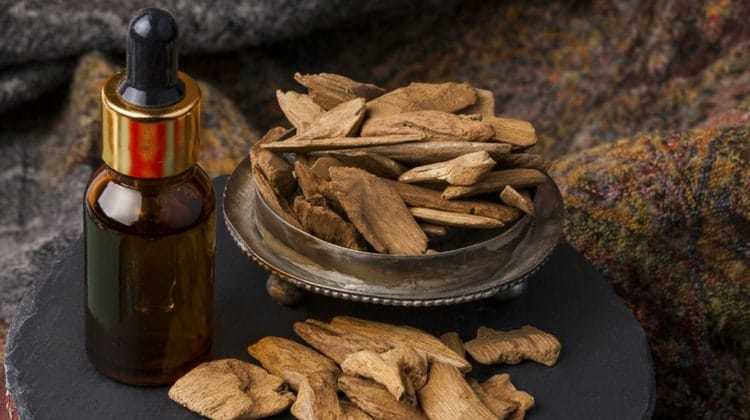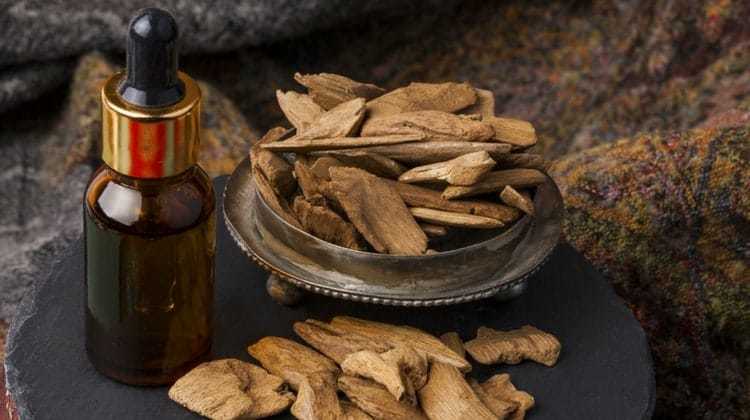What oil am I an what do I do

 Sample list of oils an best application for use
Sample list of oils an best application for use
- Scars – Wheat Germ Oil
- Stretch marks – Sesame Oil
- Wrinkles – Apricot Kernel Oil or Evening Primrose Oil
- Oily skin – Safflower Oil or Sunflower Oil
- Normal, Itchy, Sensitive skin – Sweet Almond Oil
- Dry skin – Sweet Almond Oil or Avocado Oil
- Rough skin – Olive Oil
Information updated for more detail of oils in list
Agar oil
Agar oil or oodh, distilled from agar wood (Aquilaria malaccensis). Highly prized for its fragrance.
Agar oil is the product of a natural chain of events. It is extracted from various species of Aquilaria infiltrated?by a specific species of fungi. The tree’s self-defense mechanism, or its “damage sap” changes the chemical composition of the wood, making it heavier and darker in color. To extract the essential oil, the wood needs to go through the steam distillation process.
Benefits
Anti-Inflammatory
Pain Reliever and Fever Reducer
Disinfectant
Laxative
Sedative
Manage Alzheimer’s
Medicines for Alzheimer’s disease have one main function: they slow the breakdown of?acetylcholine. Acetylcholine is broken down by Acetylcholinesterase?(AChE). Agar oil contains AChE inhibitors, which means it may help slow down the effects of Alzheimer’s. If diagnosed, it is best to talk to your doctor about using Agar oil in your treatments.
Anise oil
Anise oil, from the Pimpinella anisum, rich odor of licorice
Anise is an herb. The seed and oil are used to make medicine. Less commonly, the root and leaf are used to make medicine as well. Do not confuse anise with other herbs called star anise or fennel. These are sometimes called anise.
Anise is used for upset stomach, intestinal gas, runny nose, and as an expectorant to increase productive cough. It is also used to increase urination and to stimulate the appetite. Women use anise to increase milk flow when nursing, start menstruation, treat menstrual discomfort or pain, ease childbirth, and increase sex drive. Men use anise to treat symptoms of "male menopause." Other uses include treatment of seizures, nicotine dependence, trouble sleeping (insomnia), asthma, diabetes, and constipation.
There are a lot of oils still getting to know the oils if you have had experience with any beneficial oils below please drop us a line via contacts page
Asafoetida oil, used to flavor food.
Balsam of Peru, from the Myroxylon, used in food and drink for flavoring, in perfumes and toiletries for fragrance
Basil oil, used in making perfumes, as well as in aromatherapy
Bay oil is used in perfumery and aromatherapy
Bergamot oil, used in aromatherapy and in perfumes.
Black pepper oil is distilled from the berries of Piper nigrum.
Birch oil used in aromatherapy
Camphor oil
Cannabis flower essential oil, used as a flavoring in foods, primarily candy and beverages. Also used as a scent in perfumes, cosmetics, soaps, and candles.
Calamodin oil or calamansi essential oil comes from a citrus tree in the Philippines extracted via cold press or steam distillation.
Caraway seed oil, used a flavoring in foods. Also used in mouthwashes, toothpastes, etc. as a flavoring agent.
Cardamom seed oil, used in aromatherapy. Extracted from seeds of subspecies of Zingiberaceae
Carrot seed oil, used in aromatherapy.
Cedar oil (or cedarwood oil), primarily used in perfumes and fragrances.
Chamomile oil, there are many varieties of chamomile but only two are used in aromatherapy, Roman and German. German chamomile contains a higher level of the chemical azulene
Calamus oil Used in perfumery and formerly as a food additive
Cinnamon oil, used for flavoring
Cistus ladanifer leaves and flowers used in perfumery.
Citron oil, used in Ayurveda and perfumery.
Citronella oil, from a plant related to lemon grass is used as an insect repellent
Clary Sage oil, used in perfumery and as an additive flavoring in some alcoholic beverages.
Coconut oil, used for skin, food, and hair
Clove oil used in perfumery and medicinally.
Coffee oil, used to flavor food.
Coriander oil
Costmary oil (bible leaf oil), formerly used medicinally in Europe; still used as such in southwest Asia. Discovered to contain up to 12.5% of the toxin β-thujone.
Costus root oil
Cranberry seed oil, equally high in omega-3 and omega-6 fatty acids, primarily used in the cosmetic industry.
Cubeb oil, used to flavor foods.
Cumin seed oil/black seed oil, used as a flavor, particularly in meat products
Cypress oil, used in cosmetics
Cypriol
Curry leaf oil, used to flavor food.
Davana oil, from the Artemisia pallens, used as a perfume ingredient
Dill oil, chemically almost identical to Caraway seed oil. High carvone content.
Elecampane oil
Elemi oil, used as a perfume and fragrance ingredient. Comes from the oleoresins of Canarium luzonicum and Canarium ovatum which are common in the Philippines.
Eucalyptus oil, historically used as a germicide.
Fennel seed oil
Fenugreek oil, used for cosmetics from ancient times.
Fir oil
Frankincense oil, used in aromatherapy and in perfumes.
Galangal oil used to flavor food.
Galbanum oil, used in perfumery.
Garlic oil is distilled from Allium sativum.
Geranium oil, also referred to as geranol. Used in herbal medicine, aromatherapy, and perfumery.
Ginger oil, used medicinally in many cultures, and has been studied extensively as a nausea treatment, where it was found more effective than placebo.
Goldenrod oil used in herbal medicine, including treatment of urological problems.
Grapefruit oil, extracted from the peel of the fruit. Used in aromatherapy. Contains 90% limonene.
Henna oil, used in body art. Known to be dangerous to people with certain enzyme deficiencies. Pre-mixed pastes are considered dangerous, primarily due to adulterants.
Helichrysum oil
Hickory nut oil
Horseradish oil
Hyssop
Idaho-grown Tansy
Jasmine oil, used for its flowery fragrance.
Juniper berry oil, used as a flavor.
Laurus nobilis
Lavender oil, used primarily as a fragrance.
Ledum
Lemon oil, similar in fragrance to the fruit. Unlike other essential oils, lemon oil is usually cold pressed. Used in cosmetics.
Lemongrass. Lemongrass is a highly fragrant grass from India. The oil is very useful for insect repellent.
Lime
Litsea cubeba oil, lemon-like scent, often used in perfumes and aromatherapy.
Linalool
Mandarin
Marjoram
Melissa oil (Lemon balm), sweet smelling oil
Mentha arvensis oil, mint oil, used in flavoring toothpastes, mouthwashes and pharmaceuticals, as well as in aromatherapy.
Moringa oil, can be used directly on the skin and hair. It can also be used in soap and as a base for other cosmetics.
Mountain Savory
Mustard oil, containing a high percentage of allyl isothiocyanate or other isothiocyanates, depending on the species of mustard
Myrrh oil, warm, slightly musty smell.
Myrtle
Neem oil or neem tree oil
Neroli is produced from the blossom of the bitter orange tree.
Nutmeg oil
Orange oil, like lemon oil, cold pressed rather than distilled. Consists of 90% d-Limonene. Used as a fragrance, in cleaning products and in flavoring foods.
Oregano oil, contains thymol and carvacrol
Orris oil is extracted from the roots of the Florentine iris (Iris florentina), Iris germanica and Iris pallida. It is used as a flavouring agent, in perfume, and medicinally.
Palo Santo
Palmarosa Essential oil (contains 70% to 80% geraniol, geranyl acetate) Have a hint of rose smell
Parsley oil, used in soaps, detergents, colognes, cosmetics and perfumes, especially men's fragrances.
Patchouli oil, very common ingredient in perfumes.
Perilla essential oil, extracted from the leaves of the perilla plant. Contains about 50–60% perillaldehyde.
Pennyroyal oil, highly toxic. It is abortifacient and can even in small quantities cause acute liver and lung damage.
Peppermint oil
Petitgrain
Pine oil, used as a disinfectant, and in aromatherapy.
Ravensara
Red Cedar
Roman Chamomile
Rose oil, distilled from rose petals, used primarily as a fragrance.
Rosehip oil, distilled from the seeds of the Rosa rubiginosa or Rosa mosqueta.
Rosemary oil, distilled from the flowers of Rosmarinus officinalis.
Rosewood oil, used primarily for skin care applications.
Sage oil,
Sandalwood oil, used primarily as a fragrance, for its pleasant, woody fragrance.
Sassafras oil, from sassafras root bark. Used in aromatherapy, soap-making, perfumes, and the like. Formerly used as a spice, and as the primary flavoring of root beer, inter alia. Sassafras oil is heavily regulated in the United States due to its high safrole content.
Savory oil, from Satureja species. Used in aromatherapy, cosmetic and soap-making applications.
Schisandra oil
Spearmint oil, often used in flavoring mouthwash and chewing gum, among other applications.
Spikenard
Spruce oil
Star anise oil, highly fragrant oil using in cooking. Also used in perfumery and soaps, has been used in toothpastes, mouthwashes, and skin creams.90% of the world's star anise crop is used in the manufacture of Tamiflu, a drug used to treat influenza, and is hoped to be useful for avian flu
Tangerine
Tarragon oil, distilled from Artemisia dracunculus
Tea tree oil, extracted from Melaleuca alternifolia.
Thyme oil
Tsuga belongs to the pine tree family.
Turmeric, used to flavor food.
Valerian
Warionia, used as a perfume ingredient
Vetiver oil (khus oil) a thick, amber oil, primarily from India. Used as a fixative in perfumery, and in aromatherapy.
Western red cedar
Wintergreen
Yarrow oil
Ylang-ylang